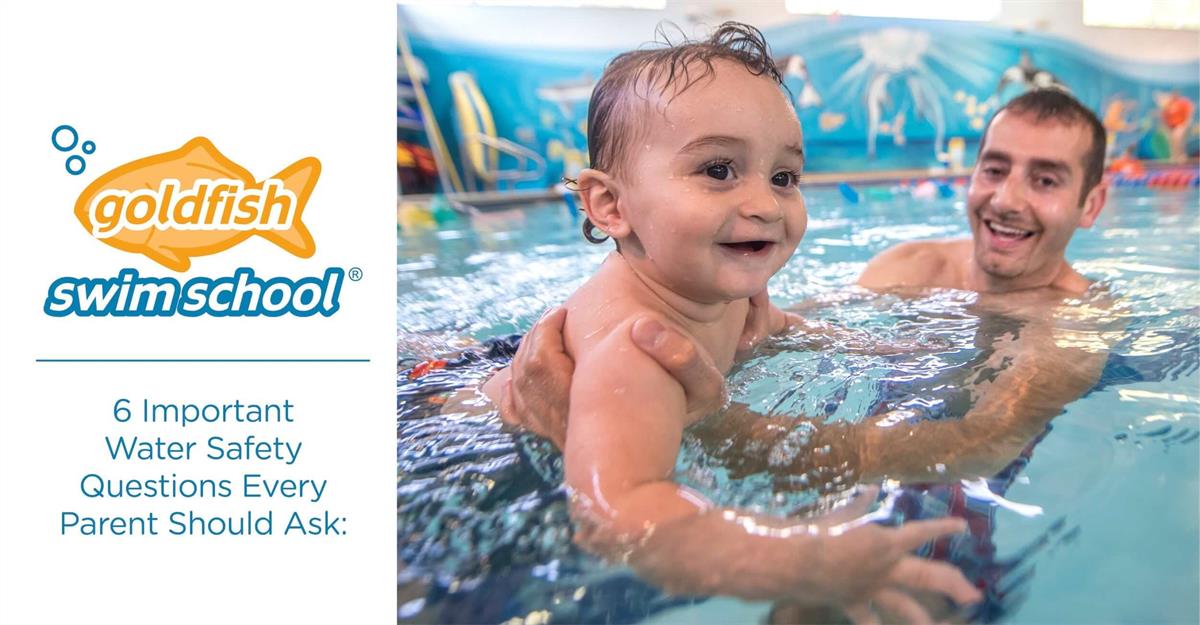Water Safety Day is May 20: Here are 6 Important Water Safety Questions Every Parent Should Ask

We want you to enjoy your spring and summer – safely. That’s why our instructors at Goldfish Swim School use integrity, compassion and trust to incorporate water safety skills into each and every lesson. And, several times a year, we put even more focus onto teaching water safety.
International Water Safety Day is May 15, and this year we’ll be celebrating on Saturday, May 20, 2017! We’ll have events at most of our Goldfish Swim School locations across the country – including water safety presentations, water safety skill stations in the pool for kids to practice, free open swim, visits from local police and fire departments, games, food and more. Call the Goldfish Swim School location near you to find out what special events are going on! (It’s free and open to the public, so you don’t have to be a member to enjoy this GOLDEN experience!)
But no matter the time of year, you should always know water safety steps to keep you and your kids safer in the water.
Here are 6 Important Water Safety Questions Every Parent Should Ask:
1. When can my child swim alone?
We want to teach our kids independence, but we always want them to stay safe. So when is it OK for your child to swim alone – and by alone we mean with you nearby, but not necessarily right there in the water? Is it ever OK? It’s always a good idea to have a buddy in the water at all times, and every child and situation is different and needs to be analyzed accordingly. But, we have some tips for you here.
2. When should we use puddle jumpers and/or life jackets?
When learning to swim, we believe it is more beneficial for kids to learn without water wings, puddle jumpers or life jackets. However, every child should always wear life jackets when on a boat (and it’s generally the law in every state that kids ages 13 and younger must wear life jackets on boats). Beyond that, you’ll have to consider what kids of water you’re in, how deep it is, your child’s skill level, if you’re in the water, and other issues.
3. What are the signs of drowning?
Drowning happens quickly, and it can be difficult to notice because it doesn’t involve crazy splashing and loud yelling. If someone is having trouble in the water, they may quietly slip under the water. That’s why it’s important to recognize the signs of drowning and what to do if someone appears in distress.
4. How can I help my kids become better swimmers?
Did you know that teaching kids water safety helps kids to become better swimmers? It’s true. When kids – and all of us, really – understand what it takes to be safer in the water and implement those points, the focus can be on improving swim skills. Perpetual (year-round) swim lessons are best and truly helps keeps kids safer in the water.
5. How can we stay safe in an indoor pool?
Even if you’re not swimming outdoors, there are certain considerations that need to be made to stay safe at an indoor pool. For instance, make sure young children aren’t enticed to go near the pool unattended to scoop up toys randomly floating around – and always keep an eye on your kids, even if there’s a lifeguard on duty (and there should be!).
6. What to do if I don’t know how to swim?
It can be quite the conundrum: How do you keep your kids safe in the water when you don’t know how to swim yourself? First of all, it’s important to not impart any fear of the water onto your kids (even unconsciously). And teaching your kids to swim and learn the 5 things every kid should know how to do in the water helps empower your kids and allows them (and you!) to be safer and confident in the water.
Increase water safety skills at Goldfish Swim School
Babies as young as 4 months old can – and should! – learn to swim at Goldfish Swim School! Call a location near you to sign up today. We offer a variety of levels for all skill levels, WOW! customer service, 90-degree pool water, extraordinary results and other perks that make Goldfish Swim School the best place to learn to swim.



